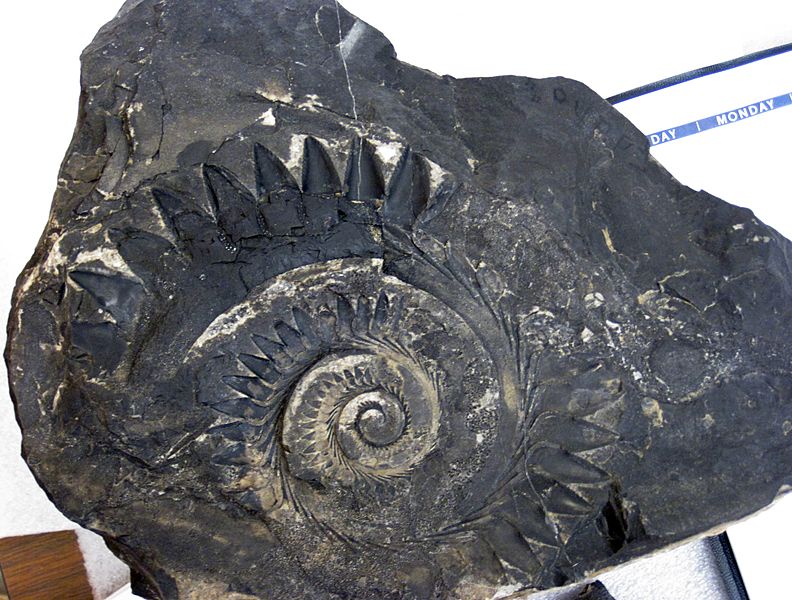Image: Helicoprion ferrieri (fossil shark tooth whorl) in phosphatic limestone (Phosphoria Formation, mid-Permian; Waterloo Mine, near Montpelier, Idaho, USA) 1 (34367874135)

Description: Helicoprion ferrieri (Hay, 1907) - fossil shark tooth whorl from the Permian of Idaho, USA. (IMNH 37899, Idaho Museum of Natural History, Idaho State University, Pocatello, Idaho, USA) This remarkable fossil is a symphyseal tooth whorl from the lower jaw of an edestoid shark. It is in phosphatic limestone of the Permian-aged Phosphoria Formation in Idaho. Sharks have a cartilaginous skeleton and mineralized, phosphatic teeth (as are all vertebrate teeth). Helicoprion is undoubtedly the strangest shark in geologic history (see reconstructions elsewhere in this photo album and at the links given below). Helicoprion tooth whorls are almost always in large concretions, which are subspherical to rounded discoidal masses of relatively hard, fine-grained material (e.g., siderite, calcite, iron oxides). In the Idaho example shown above, the concretion is phosphate-rich carbonate rock. Permian phosphorite successions in southeastern Idaho are fossiliferous and include Helicoprion tooth spirals. The high-grade phosphorite rocks have economic significance and are mined. At the Monsanto phosphorite mine in Idaho, the waste rock piles are huge and rich in fossils. The general stratigraphy at the Monsanto mine is: Bed of low-grade phosporus ore Shale with concretions (waste rock) Center waste shale (waste rock) Chert layer (waste rock) Bed of high-grade phosphorus ore Some paleontologists have interpreted the tooth whorl of Helicoprion sharks as part of a externally coiled lower jaw that may have been whipped outward and back to capture fish prey. Although intriguing, this type of reconstruction is incorrect. Instead, the tooth whorl was internal (inside the lower jaw tissues), and occupied the entire length of the lower jaw. The latter interpretation is based on the specimen shown above - it has soft-part preservation exposed at the surface, and CT scanning revealed more soft-part structures inside the rock specimen (see links below). The spiral has been interpreted as a single tooth with numerous cusps. The oldest cusps are the smallest and occur at the center of the whorl. New, larger cusps were generated near the articulation joint between the shark's lower jaw (mandible) and the rest of the head. Helicoprion was an experiment in tooth retention - this shark could not eject teeth, unlike modern sharks. Helicoprion sharks had modern-style scales on the body surface. Such scales result in no ripples and no sound while swimming - useful features in a marine predator. The classic interpretation of this shark having an external, open whorl as its lower jaw defeats the no-ripples-no-sound advantage of modern-style shark scales. An open, external tooth whorl is not hydrodynamic. Classification: Animalia, Chordata, Vertebrata, Chondrichthyes, Elasmobranchii, Eugeneodontida, Edestoidea, Agassizodontidae/Helicoprionidae Stratigraphy: Phosphoria Formation, Roadian Stage to Wordian Stage, mid-Permian Locality: Waterloo Mine, Southeastern Idaho Phosphate Mining District, near the town of Montpelier, southeastern Idaho, USA Thanks to Jesse Pruitt who provided info. and access to Helicoprion museum specimens. See info. at: <a href="http://web.uri.edu/celsnews/two-uri-biologists-solve-mystery-of-a-strange-ancient-shark/" rel="nofollow">web.uri.edu/celsnews/two-uri-biologists-solve-mystery-of-...</a> and <a href="http://rsbl.royalsocietypublishing.org/content/9/2/20130057" rel="nofollow">rsbl.royalsocietypublishing.org/content/9/2/20130057</a>
Title: Helicoprion ferrieri (fossil shark tooth whorl) in phosphatic limestone (Phosphoria Formation, mid-Permian; Waterloo Mine, near Montpelier, Idaho, USA) 1 (34367874135)
Credit: Helicoprion ferrieri (fossil shark tooth whorl) in phosphatic limestone (Phosphoria Formation, mid-Permian; Waterloo Mine, near Montpelier, Idaho, USA) 1
Author: James St. John
Usage Terms: Creative Commons Attribution 2.0
License: CC BY 2.0
License Link: https://creativecommons.org/licenses/by/2.0
Attribution Required?: Yes
Image usage
The following page links to this image:

